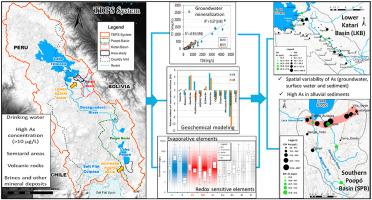当前位置:
X-MOL 学术
›
J. South Am. Earth Sci.
›
论文详情
Our official English website, www.x-mol.net, welcomes your feedback! (Note: you will need to create a separate account there.)
Hydrogeochemical contrasts in the shallow aquifer systems of the Lower Katari Basin and Southern Poopó Basin, Bolivian Altiplano
Journal of South American Earth Sciences ( IF 1.8 ) Pub Date : 2021-01-01 , DOI: 10.1016/j.jsames.2020.102914 Israel Quino Lima , Mauricio Ormachea Muñoz , Oswaldo Eduardo Ramos Ramos , Jorge Quintanilla Aguirre , Jyoti Prakash Maity , Arslan Ahmad , Prosun Bhattacharya
Journal of South American Earth Sciences ( IF 1.8 ) Pub Date : 2021-01-01 , DOI: 10.1016/j.jsames.2020.102914 Israel Quino Lima , Mauricio Ormachea Muñoz , Oswaldo Eduardo Ramos Ramos , Jorge Quintanilla Aguirre , Jyoti Prakash Maity , Arslan Ahmad , Prosun Bhattacharya

|
Abstract Drinking water sources in the southeastern part of Lake Titicaca (Lower Katari Basin: LKB) and the southern part of Lake Poopo (Southern Poopo Basin: SPB) have high concentrations of arsenic (As), >10 μg/L compared to the WHO and NB-512 guideline value. These regions belong to the Bolivian Altiplano and are characterized by a semiarid climate, slow hydrological flow, with geological formations of volcanic origin, in addition to brines and other mineral deposits. The present study is focused on comparing the geochemical processes of As in relation to the sources and mobilization in groundwater (GW) in LKB and SPB. Groundwater, surface water and sediment samples were collected from both basins. The As (LKB: 0.8–288 μg/L and SPB: 2.6–207 μg/L), boron (B) (LKB: 96–2473 μg/L and SPB: 507–4359 μg/L), manganese (Mn) (LKB: 0.6–7259 μg/L) and salinity (LKB: 125–11740 μS/cm) were found to be higher than the WHO guideline limit, which is a serious concern about the GW quality for human consumption. The dissolution and exchange of bases are the processes that govern the mineralization of GW. Load of solids and liquids of anthropogenic origin in surface water (LKB) represents an environmental problem for communities on river banks. The spatial distribution of As was attributed to the geology of both the basins and the heterogeneously distributed evaporites in the sediments. The highest As concentrations are found in alluvial sediments of the northern region of LKB and the “PACK belt” (an approximately 25 km long belt stretching along the southern shores of the Lake Poopo, between the villages of Pampa Aullagas and Condo K) in SPB. Sequential extraction of sediment and mineral saturation indices indicate that iron (Fe) and aluminum (Al) oxides as well as hydroxides are the most predominant mineral phases as potential sorbents of As.
中文翻译:

玻利维亚高原下卡塔里盆地和南波波盆地浅层含水层系统的水文地球化学对比
摘要 的的喀喀湖东南部(Lower Katari Basin:LKB)和波波湖南部(Southern Poopo Basin:SPB)的饮用水源中砷(As)浓度较高,与 WHO 相比 >10 μg/L和 NB-512 准则值。这些地区属于玻利维亚高原,以半干旱气候、缓慢的水文流动、火山起源的地质构造以及盐水和其他矿藏为特征。本研究的重点是比较 LKB 和 SPB 中 As 的地球化学过程与地下水 (GW) 来源和迁移相关的关系。从两个盆地收集地下水、地表水和沉积物样品。As(LKB:0.8–288 μg/L 和 SPB:2.6–207 μg/L)、硼 (B)(LKB:96–2473 μg/L 和 SPB:507–4359 μg/L)、锰 (Mn) (LKB:0。6–7259 μg/L) 和盐度 (LKB: 125–11740 μS/cm) 被发现高于 WHO 指南限值,这是对人类消费 GW 质量的严重关注。碱的溶解和交换是控制 GW 矿化的过程。地表水 (LKB) 中人为来源的固体和液体的负载代表了河岸社区的环境问题。As 的空间分布归因于盆地的地质和沉积物中不均匀分布的蒸发岩。在 SPB 的 LKB 北部地区和“PACK 带”(一条大约 25 公里长的带,沿着波波湖的南岸,在 Pampa Aullagas 和 Condo K 村之间)的冲积沉积物中发现了最高的 As 浓度.
更新日期:2021-01-01
中文翻译:

玻利维亚高原下卡塔里盆地和南波波盆地浅层含水层系统的水文地球化学对比
摘要 的的喀喀湖东南部(Lower Katari Basin:LKB)和波波湖南部(Southern Poopo Basin:SPB)的饮用水源中砷(As)浓度较高,与 WHO 相比 >10 μg/L和 NB-512 准则值。这些地区属于玻利维亚高原,以半干旱气候、缓慢的水文流动、火山起源的地质构造以及盐水和其他矿藏为特征。本研究的重点是比较 LKB 和 SPB 中 As 的地球化学过程与地下水 (GW) 来源和迁移相关的关系。从两个盆地收集地下水、地表水和沉积物样品。As(LKB:0.8–288 μg/L 和 SPB:2.6–207 μg/L)、硼 (B)(LKB:96–2473 μg/L 和 SPB:507–4359 μg/L)、锰 (Mn) (LKB:0。6–7259 μg/L) 和盐度 (LKB: 125–11740 μS/cm) 被发现高于 WHO 指南限值,这是对人类消费 GW 质量的严重关注。碱的溶解和交换是控制 GW 矿化的过程。地表水 (LKB) 中人为来源的固体和液体的负载代表了河岸社区的环境问题。As 的空间分布归因于盆地的地质和沉积物中不均匀分布的蒸发岩。在 SPB 的 LKB 北部地区和“PACK 带”(一条大约 25 公里长的带,沿着波波湖的南岸,在 Pampa Aullagas 和 Condo K 村之间)的冲积沉积物中发现了最高的 As 浓度.



























 京公网安备 11010802027423号
京公网安备 11010802027423号